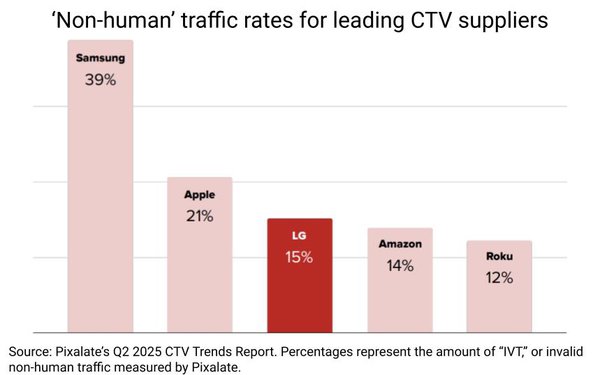
A funny thought came to me while watching last week's live agentic media buy between two bots representing the supply-and-demand
side: how much of the audience its ads were served to were also bots? Hear me out.
I know that sounds weird, but as I was watching the transaction something stuck out for me when the
buyer's bot requested inventory and the seller's bot offered a package of CTV inventory from one supplier: LG Ads.
It stuck out because I recalled seeing a recent analysis of CTV ad suppliers from invalid traffic tracker Pixalate showing that 15% of LG Ads'
impressions are from IVT, or non-human traffic. You know, bots.
advertisement
advertisement
To be fair, LG is far from the worst CTV inventory offender in terms of delivering non-human traffic (see above), and it wasn't
clear from watching the closed-loop agentic transaction between Scope3's buyer bot and Swivel's seller bot whether it actually filtered IVT out or not, but it made me think about the agentic world we
are moving into and whether the transaction wasn't just agent-to-agent, but A2A2A, meaning at least some of it was served to an AI agent posing as human audience.
And while that might not be a
good thing by today's ad fraud standards, it might not be considered such a bad thing in the future when A2A marketing means trying to reach -- and influence -- a bot representing a human
consumer.
I know that's a high concept for some planners and buyers to get their minds around, but it's important that you do, because in a truly agentic world, bots won't just be
transacting B2B. They'll also be transacting B2B2C, meaning the C will also have a bot in the mix representing its interests in the marketing transaction.
One aspect of that transaction might
be whether the consumer's bot even enable's a marketer's bot to serve them an ad in the first place, or what kind of data the consumer's bot will share with the marketer's bot as the basis of an
overall transaction.
It's a high concept for sure, but it's not coming out of nowhere and there have been communities of big thinkers working on creating more information symmetry for the
consumer-side of the marketing mix, especially project VRM, a mostly academic and well-intentioned tech community initiative trying to figure out how to flip the industry's model from "CRM" (Customer
Relationship Management) to "VRM" (Vendor Relationship Management).
Add MRM's new ARM
(Agent Relationship Management) to the mix and you've got more than just a lot of acronyms. You've got a new paradigm.
If you want to learn more about Project VRM, it will be hosting a "VRM Day" today in Silicon Valley, and I'm told there will be some kind of video access, which I will
update a link with as soon as I get it.
One of the important things you should know about this event, is that it will also be the first public vetting of a new consumer marketing protocol
embodied as a technical standard developed by the IEEE (Institute of Electrical and Electronics Engineers) for machine readable privacy terms
between the marketing and media industries and consumers. You can read more about the proposed standard, which has been dubbed "MyTerms," on Project VRM founder and organizer Doc Searls blog.
I don't expect many of you to geek out on the new MyTerms protocol any more than I'd expect many to actually go on the Agentic
Advertising Standards & Community's Github page to dig into its new AdCP agentic advertising protocol.
Both are technically dense, but I just wanted you to be aware of what's happening so
you can prepare and adapt, because we are moving into an increasingly agentic world in which bots will be interacting with bots that are interacting with bots.
And I know I've quipped about
this before, but as unimaginable as it sounds when I say advertisers and agencies will soon need to rethink the validity of bot traffic in their media buys, you may actually be paying a premium for
the right ones one day soon.